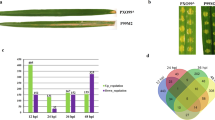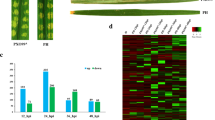Abstract
Necrotrophic pathogens experience host-generated oxidative stress during pathogenesis. They overcome such hostile environment by intricate mechanisms which are largely understudied. In this article, reference-based transcriptome analysis of a devastating Ascochyta Blight (AB) disease causing chickpea pathogen Ascochyta rabiei was explored to get insights into survival mechanisms under oxidative stress. Here, expression profiling of mock-treated and menadione-treated fungus was carried out by RNA-Seq approach. A significant number of genes in response to oxidative stress were overrepresented, suggestive of a robust and coordinated defense system of A. rabiei. A total 73 differentially expressed genes were filtered out from both the transcriptomes, among them 64 were up-regulated and 9 were found down-regulated. The gene ontology and KEGG mapping were conducted to comprehend the possible regulatory roles of differentially expressed genes in metabolic networks and biosynthetic pathways. Transcript profiling, KEGG pathway and gene ontology-based enrichment analysis revealed 12 (16.43%) stress responsive factors, 25 (34.24%) virulence associated genes, 10 (13.69%) putative effectors and 28 (38.35%) important interacting proteins associated with various metabolic pathways. In addition, genes with differential expression were further explored for underlying putative pathogenicity factors. We identified five genes ST47_g10291, ST47_g9396, ST47_g10294, ST47_g4395, and ST47_g7191 that were common to stress and fungal pathogenicity. The factors recognized in this work can be used to establish molecular tools to explain the regulatory gene networks engaged in stress response of fungal pathogens and disease management.







Similar content being viewed by others
Data availability and materials
All data analysed during this study are included in this published article and its additional files. The raw RNA-sequencing data are deposited in the NCBI GenBank (www.ncbi.nlm.nih.gov) under study accessions SRX5765333 and SRX5765332, which can be retrieved under the BioProject accession number PRJNA539845.
References
Asai S, Yoshioka H (2009) Nitric oxide as a partner of reactive oxygen species participates in disease resistance to necrotrophic pathogen Botrytis cinerea in Nicotiana benthamiana. Mol Plant Microbe Interact 22(6):619–629
Asai S, Ohta K, Yoshioka H (2008) MAPK signaling regulates nitric oxide and NADPH oxidase-dependent oxidative bursts in Nicotiana benthamiana. Plant Cell 20:1390–1406
Besson-Bard A, Pugin A, Wendehenne D (2008) New insights into nitric oxide signaling in plants. Annu Rev Plant Biol 59:21–39
Dean R, Van Kan JA, Pretorius ZA, Hammond-Kosack KE, Di Pietro A, Spanu PD, Rudd JJ, Dickman M, Kahmann R, Ellis J, Foster GD (2012) Top 10 fungal pathogens in molecular plant pathology. Mol Plant Pathol 13(4):414–430
Gilad NL, Bar-Nun N, Noy T, Mayer AM (2000) Enzymes of Botrytis cinerea capable of breaking down hydrogen peroxide. FEMS Microbiol Lett 190:121–126
Glazebrook J (2005) Contrasting mechanisms of defense against biotrophic and necrotrophic pathogens. Annu Rev Phytopathol 43:205–227
Götz S, García-Gómez JM, Terol J, Williams TD, Nagaraj SH, Nueda MJ, Robles M, Talón M, Dopazo J, Conesa A (2008) High-throughput functional annotation and data mining with the Blast2GO suite. Nucleic Acids Res 36:3420–3435
Govrin E, Levine A (2000) The hypersensitive response facilitates plant infection by the necrotrophic pathogen Botrytis cinerea. Curr Biol 10:751–757
Guo M, Guo W, Chen Y, Dong S, Zhang X et al (2010) The basic leucine zipper transcription factor Moatf1 mediates oxidative stress responses and is necessary for full virulence of the rice blast fungus Magnaporthe oryzae. Mol Plant Microbe Interact 23:1053–1068
Hemetsberger C, Herrberger C, Zechmann B, Hillmer M, Doehlemann G (2012) The Ustilago maydis effector Pep1 suppresses plant immunity by inhibition of host peroxidase activity. PLoS Pathog 8(5):e1002684
Höhl B, Pfautsch M, Barz W (1990) Histology of disease development on resistant and susceptible cultivars of chickpea (Cicer arietinum L.) inoculated with spores of Ascochyta rabiei. J Phytopathol 129:31–45
Kanehisa M, Araki M, Goto S, Hattori M, Hirakawa M, Itoh M, Katayama T, Kawashima S, Okuda S, Tokimatsu T, Yamanishi Y (2008) KEGG for linking genomes to life and the environment. Nucleic Acids Res 36:D480–D484
Karányi Z, Holb I, Hornok L, Pócsi I, Miskei M (2013) FSRD: fungal stress response database. Database (Oxford) 2013:bat037. https://doi.org/10.1093/database/bat037
Kim NH, Kim BS, Hwang BK (2013) Pepper arginine decarboxylase is required for polyamine and γ-aminobutyric acid signaling in cell death and defense response. Plant Physiol 162(4):2067–2083
Kim D, Langmead B, Salzberg SL (2015) HISAT: a fast spliced aligner with low memory requirements. Nat Methods 12(4):357–360
Lambou K, Lamarre C, Beau R, Dufour N, Latge JP (2010) Functional analysis of the superoxide dismutase family in Aspergillus fumigatus. Mol Microbiol 75:910–923
Lehmann S, Serrano M, L’Haridon F, Tjamos SE, Metraux JP (2015) Reactive oxygen species and plant resistance to fungal pathogens. Phytochemistry 112:54–62
Li W, Godzik A (2006) Cd-hit: a fast program for clustering and comparing large sets of protein or nucleotide sequences. Bioinformatics 22(13):1658–1659
Lyu X, Shen C, Xie J et al (2015) A “footprint” of plant carbon fixation cycle functions during the development of a heterotrophic fungus. Sci Rep 5:12952
Mao D, Luo Y, Cheng M, Zhang J (2005) Functional grouping of yeast genes via biclustering microarray data. Front Biosci 10:2669–2675
Marroquin-Guzman M, Hartline D, Wright JD, Elowsky C, Bourret TJ, Wilson RA (2017) The Magnaporthe oryzae nitrooxidative stress response suppresses rice innate immunity during blast disease. Nat Microbiol 2:17054
Mayer AM, Staples RC, Gil-ad NL (2001) Mechanisms of survival of necrotrophic fungal plant pathogens in hosts expressing the hypersensitive response. Phytochemistry 58:33–41
Nizam S, Singh K, Verma PK (2010) Expression of the fluorescent proteins DsRed and EGFP to visualize early events of colonization of the chickpea blight fungus Ascochyta rabiei. Current Genetics 56(4):391–399
Otte O, Barz W (1996) The elicitor-induced oxidative burst in cultured chickpea cells drives the rapid insolubilization of two cell wall structural proteins. Planta 200:238–246
Oughtred R, Stark C, Breitkreutz BJ, Rust J, Boucher L, Chang C, Kolas N, O’Donnell L, Leung G, McAdam R, Zhang F, Dolma S, Willems A, Coulombe-Huntington J, Chatr-Aryamontri A, Dolinski K, Tyers M (2019) The BioGRID interaction database: 2019 update. Nucleic Acids Res 47:D529–D541
Pertea M, Pertea GM, Antonescu CM, Chang TC, Mendell JT, Salzberg SL (2015) StringTie enables improved reconstruction of a transcriptome from RNA-seq reads. Nat Biotechnol 33:290–295
Petersen TN, Brunak S, von Heijne G, Nielsen H (2011) SignalP 4.0: discriminating signal peptides from transmembrane regions. Nat Methods 8(10):785–786
Pietrowska E, Rozalska S, Kazmierczak A, Nawrocka J, Malolepsza U (2015) Reactive oxygen and nitrogen (ROS and RNS) species generation and cell death in tomato suspension cultures-Botrytis cinerea interaction. Protoplasma 252(1):307–319
Pradhan A, Herrero-de-Dios C, Belmonte R, Budge S, Lopez Garcia A, Kolmogorova A et al (2017) Elevated catalase expression in a fungal pathogen is a double-edged sword of iron. PLoS Pathog 13(5):e1006405
Sarkar TS, Biswas P, Ghosh SK, Ghosh S (2014) Nitric oxide production by necrotrophic pathogen Macrophomina phaseolina and the host plant in charcoal rot disease of Jute: complexity of the interplay between necrotroph-host plant interactions. PLoS ONE One 9(9):17
Schmieder R, Edwards R (2011) Quality control and preprocessing of metagenomic datasets. Bioinformatics 27(6):863–864
Schoonbeek H, Del Sorbo G, De Waard MA (2001) The ABC transporter BcatrB affects the sensitivity of Botrytis cinerea to the phytoalexin resveratrol and the fungicide Fenpiclonil. Mol Plant Microbe Interact 14(4):562–571
Seong K, Hou Z, Tracy M, Kistler HC, Xu JR (2005) Random insertional mutagenesis identifies genes associated with virulence in the wheat scab fungus Fusarium graminearum. Phytopathology 95(7):744–750
Shannon P, Markiel A, Ozier O, Baliga NS, Wang JT, Ramage D, Amin N, Schwikowski B, Ideker T (2003) Cytoscape: a software environment for integrated models of bimolecular interaction networks. Genome Res 13(11):2498–2504
Singh K, Nizam S, Sinha M, Verma PK (2012) Comparative transcriptome analysis of the necrotrophic fungus Ascochyta rabiei during oxidative stress: Insight for fungal survival in the host plant. PLoS ONE One 7(3):e33128
Skamnioti P, Henderson C, Zhang Z, Robinson Z, Gurr SJ (2007) A novel role for catalase B in the maintenance of fungal cell-wall integrity during host invasion in the rice blast fungus Magnaporthe grisea. Mol Plant Microbe Interact 20:568–580
Tillmann AT, Strijbis K, Cameron G, Radmaneshfar E, Thiel M, Munro CA et al (2015) Contribution of Fdh3 and Glr1 to glutathione redox state, stress adaptation and virulence in Candida albicans. PLoS ONE One 10(6):e0126940
Turrion-Gomez JL, Eslava AP, Benito EP (2010) The flavohemoglobin BCFHG1 is the main NO detoxification system and confers protection against nitrosative conditions but is not a virulence factor in the fungal necrotroph Botrytis cinerea. Fungal Genet Biol 47:484–496
Urban M, Cuzick A, Rutherford K, Irvine A, Pedro H, Pant R, Sadanadan V, Khamari L, Billal SK, Mohanty S, Hammond-Kosack KE (2017) PHI-base: a new interface and further additions for the multi-species pathogen–host interactions database. Nucleic Acids Res 45:D604–D610
Verma S, Gazara RK, Nizam S, Parween S, Chattopadhyay D, Verma PK (2016) Draft genome sequencing and secretome analysis of fungal phytopathogen Ascochyta rabiei provides insight into the necrotrophic effector repertoire. Sci Rep 6:24638
Xia J, Gill EE, Hancock RE (2015) NetworkAnalyst for statistical, visual and network-based meta-analysis of gene expression data. Nat Proto 10(6):823–844
Yang G, Rase MS, Turgeon BG, Yode OC (1996) A polyketide synthase is required for fungal virulence and production of the polyketide T-Toxin. Plant Cell 8:2139–2150
Yoshioka H, Asai S, Kobayashi M (2009) Molecular mechanisms of generation for nitric oxide and reactive oxygen species, and role of the radical burst in plant immunity. Mol Cells 28:321–329
Young MD, Wakefield MJ, Smyth GK, Oshlack A (2010) Gene ontology analysis for RNA-seq: accounting for selection bias. Genome Biol 11:R14
Acknowledgements
This work is supported by external funds from Department of Biotechnology, Government of India (Project numbers: BT/PR7164/PBD/16/1016/2012 and BT/AGR/CG-Phase II/01/2014).
Author information
Authors and Affiliations
Contributions
PKV conceptualized the idea of manuscript and supervised all the experiments. RM, YS, MS, KS and PM performed all the analysis, interpreted the results and formulated the manuscript. SKS and KP edited, and updated the manuscript. PKV, KS, KK and SV contributed critically by revising the draft provided valuable suggestions, and updating the manuscript for publication.
Corresponding authors
Ethics declarations
Conflict of interest
The authors declare that they have no conflict of interest. We have also followed the accepted principles of ethical and professional conduct and no animals or humans are involved in this research.
Electronic supplementary material
Below is the link to the electronic supplementary material.
Rights and permissions
About this article
Cite this article
Maurya, R., Singh, Y., Sinha, M. et al. Transcript profiling reveals potential regulators for oxidative stress response of a necrotrophic chickpea pathogen Ascochyta rabiei. 3 Biotech 10, 117 (2020). https://doi.org/10.1007/s13205-020-2107-8
Received:
Accepted:
Published:
DOI: https://doi.org/10.1007/s13205-020-2107-8




